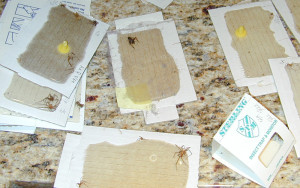
Light-duty sticky traps should be placed against a vertical surface and changed when full or when the glue surface becomes dusty. These traps have captured immature German cockroaches, suggesting a nearby cockroach harborage.
Sticky cards are glue-based traps frequently used in pest control to catch and monitor insects and other pests. Typically sticky cards consist of a sticky glue layer mounted on a piece of cardboard that is folded into a tent-structure to protect the sticky surface. Most sticky traps contain no pesticides, although some may be impregnated with aromas designed to be attractive to certain pests.
Some of the pests readily trapped by sticky traps include cockroaches, spiders, stored product pest beetles and other crawling insects, mites and scorpions. Sticky traps are less effective in trapping bed bugs and flying insects.
Sticky traps are useful for monitoring an area for crawling insects 24/7, and as such are frequently used by professionals to enhance their ability to detect pests during pest control inspections. Sticky traps allow an inspector to detect pests that are active at night or other times when people are not present.
Will sticky traps control pests?
Sticky traps are generally not very good at controlling small insect or mite pests. Their best use is to detect pests, and monitor changes in pest abundance. When multiple traps are placed in a room, they can also help pinpoint the source of an insect problem. Glue traps (see below) for control of vertebrate pests (e.g., mice or rats), however, can provide effective control when used by a knowledgeable pest control professional.
Where should sticky traps be placed?
Most insects and rodent pests prefer to travel in dark areas and along edges. Hence the best placement of a sticky card is in an out-of-the-way location in direct contact with a wall. The two open ends of the trap should run parallel to the wall to make it easy for insects to enter.
The number of traps you place out will be limited by the number of locations you have for placement and how many traps you wish to check regularly. Usually you will want to place sticky traps at least 5-10 feet apart in areas where pests are likely to travel. Behind stoves and refrigerators, in cupboards and under sinks are good places to trap cockroaches with sticky traps. Along garage and indoor walls in storage and living areas are good places to place sticky cards for brown recluse and other spiders. On either side of exterior doors or other exterior pest entry points are good places for sticky cards to trap outdoor cockroaches, beetles, crickets, scorpions and other miscellaneous crawling insects. To monitor for possible biting mites, place sticky cards in areas where bites are noticed, near attic doors or next to fireplaces where birds may be nesting.
Are glue traps the same as sticky traps?
While glue traps are a form of sticky trap, the term “glue trap” is usually used for heavier duty trapping and pest control tasks, such as catching mice and rats. Glue traps typically use a heavier, stickier glue layer applied to a stiff plastic tray. While convenient, glue traps have a lower success rate for trapping rodents, compared to snap-traps. Many people also find the use of glue traps for vertebrates objectionable or inhumane, because they do not kill the target pest immediately. Glue traps and sticky boards are sometimes used inside professional rodent bait stations to make disposal of the rodents more convenient and to help contain biohazards, such as hair and feces.
When light-duty sticky traps are not available, glue boards may substitute as insect traps; however the thicker base and lip of the glue tray may encourage many crawling insects to walk around the trap, avoiding the glue surface. Glue boards are messier than light-duty cardboard sticky traps, and the glue can be difficult to remove. Cooking oil or a solvent such as WD-40, may be useful in removing glue board glue from fingers or hair.
Where can I purchase sticky traps?
Sticky traps and glue boards can be purchased through many hardware stores or online outlets. Another commercial source may be your local pest control company or a do-it-yourself pest control shop.
